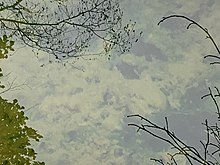Goldborn (Göritzer Fliess)
| Goldborn | |
|---|---|
 Goldborn near Werchow |
|
| location | |
| Country or region | Verkhov |
| Coordinates | 51 ° 43 ′ 13 " N , 13 ° 35 ′ 36" E |
| geology | |
| Exit type | Source pot |
| Hydrology | |
| River system | Elbe |
| Receiving waters | Göritzer Fliess → Graben-A Kamske → Spree |
| Bulk | 7 l / s |
Coordinates: 51 ° 43 ′ 13 ″ N , 13 ° 35 ′ 36 ″ E
The Goldborn is a spring in Werchow , a district of the city of Calau in the Oberspreewald-Lausitz district in Brandenburg . It is considered to be the richest spring in Lower Lusatia and is a registered natural monument .
location
The source is located around 600 m south of the town center, right next to a former restaurant and the Cabeler Berg street . To the west is the Lugteich , to the east flows hell , a right tributary of the Göritzer Fließ in north-south direction.
History and description
The Goldborn was first described in 1720 by Adam Friedrich Zürner in his atlas Augusteus der Chursächsische Lande . In 2008 the Lausitzer Rundschau reported in an article about the Goldborn that in 1757 the Göldne Born was to be found on a map by Pietrus Schenk. The Electress Anna Christine von Sachsen-Weißenfels is said to have used the water in Dresden for healing purposes in 1758 . In 1813 the community set up a bathing establishment, which was terminated in 1817.
Before lignite mining began , the volume was around 17 liters per second. After the lowering of the groundwater level, measurements only measured an average of 7 liters per second between 1999 and 2004. According to the Brandenburg State Office for the Environment , it is nevertheless the most abundant source in Lower Lusatia. The office expects that even after the end of the lignite mining it will take decades before the original discharge is reached again. The Goldborn has been a protected natural monument since 2007.
An information board at the source indicates that around 452 liters of water escape every minute. This has a pH value of 6.5 and contains around 2 mg iron per liter. This creates iron hydroxides , which give the water a golden-reddish color and, according to an information leaflet from the Ministry for the Environment, Health and Consumer Protection of the State of Brandenburg, gave the source its name.
Goldborn legend
According to an old tradition, the rushing water of the spring robbed a peasant of his sleep. He then transported a millstone to the spring with the help of two black oxen and sunk it in the spring pot. The discharge receded and the rush of water disappeared. The farmer could then sleep in peace again.
literature
- Ministry for the Environment, Health and Consumer Protection of the State of Brandenburg (Ed.): Von Schwedenlinden, Findlingen and Rummeln - Natural Monuments in Brandenburg , 2nd updated edition, 2011, p. 98
- Legends from Calau and the surrounding area, Regia Verlag 2014, p. 32, ISBN 978-3-86929-255-7
Web links
Individual evidence
- ↑ The Goldborn near Werchow . In: Lausitzer Rundschau , May 31, 2008, accessed on December 31, 2019.
- ↑ Information board on Goldborn, December 2019.
